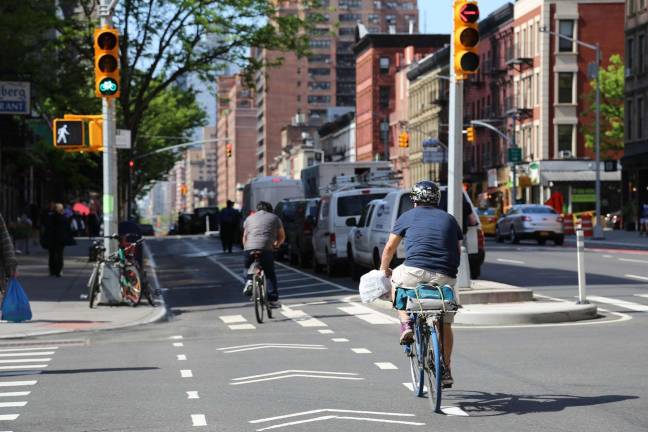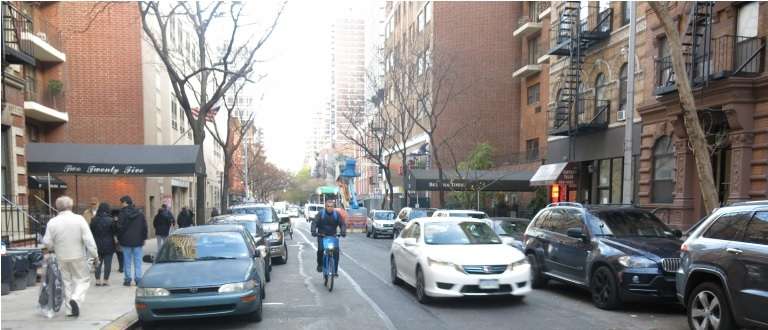THE BIG BIKE-LANE BOOM


The recent growth of the on-street bicycle network in Manhattan has been nothing short of explosive. Now, a series of catastrophic accidents that has claimed the lives of three cyclists over the past three months has galvanized support for an even more dramatic expansion.
At least 37.5 miles of bike lanes were added to the island’s signature street grid from 2014 through 2016, city Department of Transportation data shows. That’s up a sharp 77 percent from the 21.1 bike-lane miles introduced in the three-year period between 2009 and 2011.
The best-known and most heavily trafficked bikeways have taken root on the left-hand sides of principal north-south avenues, like uptown-facing First and downtown-facing Second Avenues on the East Side, and uptown Eighth and downtown Columbus Avenues on the West Side.
But the potential new expansion — which is being developed by DOT and has been pushed by community boards, transit advocates and Manhattan Borough President Gale Brewer and other elected officials — would transform the arterial infrastructure in a perpendicular direction.
Instead of positioning the bike paths primarily on the broader avenues, numerous new lanes would also be positioned on the narrower, east-west cross streets, potentially providing cyclists with a painless way of transiting between the East River and the Harlem River. Of course, that would also set the stage for painful new showdowns with pedestrians in the city’s oft-contested streetscape.
Details, locations and timetables remain sketchy: Would the plans focus mostly on adding unprotected one-way bike lanes to those that already exist on 29th, 30th, 70th, 71st, 77th, 78th, 90th and 91st Streets? Or would the new lanes be protected, barricaded and cordoned off from traffic? Or a combination of both? It’s unclear. And still on the drawing boards.
“We are actively developing a series of crosstown bike-route proposals, and we will be coming to the community with more details in the near future,” a DOT spokeswoman said on September 18.
What is clear is that tragedy has propelled the drive, helped it garner political support, and vested it with a newfound urgency. There have been six cyclist fatalities in Manhattan so far this year, DOT crash data shows. That compares to two in 2016, two in 2015, two in 2014, five in 2014 and three in 2013, according to the Vision Zero website.
Pedestrian fatalities continue to outstrip those tallies, with 10 deaths in Manhattan as of July 31. There have also been four motorist fatalities this year.
Among the horrors befalling cyclists over the past few months:
* September 14. A 48-year-old woman died of injuries sustained when she was struck by a turning box truck as she biked near the corner of Broadway and Walker Street in Tribeca. The driver who hit Lower East Side resident Yan Jindee remained at the accident scene and wasn’t charged pending an investigation.
* September 11. A woman on a CitiBike riding eastbound on West 30th Street at the corner of Seventh Avenue was struck by a dump truck driver making a right turn and briefly pinned under the vehicle. She was treated at Bellevue Hospital for body trauma, but wasn’t critically injured.
* June 17. An 80-year-old, Crete-born cobbler was struck and killed by a commercial bus as he rode south on Seventh Avenue near the corner of West 29th Street in Chelsea. Michael Mamoukakis had run Mike’s Shoe Repair, on Dey Street near the World Trade Center, for more than a quarter-century until he was forced to close the business after 9/11.
* June 12. A 36-year-old Credit Suisse financier became the first rider to die in a CitiBike accident since the system debuted in 2013 when he was struck by a charter bus on West 26th Street near Eighth Avenue, also in Chelsea. Dan Hanegby, a father of two, had been a veteran of the Israeli special forces and was a passionate tennis player.
Referring to the deaths of Hanegby and Mamoukakis, just five days and a handful of blocks apart, Brewer, in an op-ed piece in The West Side Spirit on September 14, wrote, “If there had been protected bike lanes on those streets, these two men would probably still be alive.”
Her solution: DOT should examine the island’s crosstown streets to “determine which could best accommodate protected, river-to-river bike lanes with the least amount of disturbance to traffic flows.” As for a timetable, “start building new bike lanes by next summer,” she wrote.
Also advocating for east-west bikeways was Community Board 4, which encompasses Chelsea and Hell’s Kitchen, and whose members fired off a letter to DOT Commissioner Polly Trottenberg on July 6 that also referenced the crashes that took the lives of Hanegby and Mamoukakis.
“Without crosstown protected bike lanes to connect to the network of north-south lanes, riders are in great danger on the cross streets due to the narrowness of the streets or the intense congestion on some of them,” they wrote.
“Neither painted bike lanes nor sharrows [shared-lane markings] are adequate to protect riders’ lives since they allow for double parking and for drivers to overtake the lane,” the CB 4 letter added.
Meanwhile, after the September 11 crash on West 30th Street that injured a female CitiBike rider, City Council member Corey Johnson, who represents the area and has also been pushing for bike paths on crossing streets, weighed in with a couple of blunt tweets:
“We need safer streets NOW,” Johnson wrote. “We need to do more.”